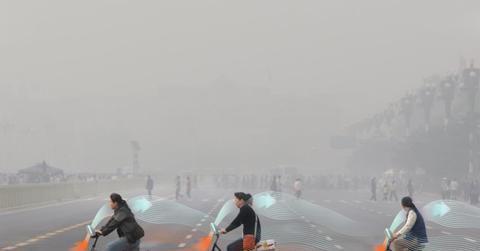Smog-Eating Bikes Become Available To 20 Million People Through New Partnership
A design firm is on a quest to create smog-free cities around the world. Their latest innovation? Bicycles that breathe in smog, trap particulates, and let out filtered air. Even better? A bike share program is in the works.
Updated May 26 2019, 2:19 p.m. ET
A design firm is on a quest to create smog-free cities around the world. Their latest innovation? Bicycles that breathe in smog, trap particulates, and let out filtered air. You already know riding a bicycle is good for you. Bicycles are great alternative modes of transportation that are healthy for the environment and super for your own physical (and mental) health. But now, bicycle culture is about to go a step further: with cycles that actually take in dirty air, clean it, and return it to the environment.
The smog problem has gone international.
First stop for these brilliant bicycles is China, where “smog red alerts” are normal fare for residents throughout the country. Pollution-based smog has been known to shut down factories, curtail scheduled commercial airline flights, and close highways.
But Xingtai, China’s city with the worst air pollution, ranks just ninth internationally for the cities with the dirtiest air. That’s especially frightening when you consider how frequently in the last several years Chinese schools have been closed, farmers have fretted because sunlight has been so severely blocked by the smog, and all kinds of health problems—from cancer to respiratory issues—have spiked. You can’t see photos of Chinese cities without also seeing people walking through them in facemasks.
The smog problem in China is due to several factors, including your run-of-the-mill pollution from traffic and industry. But it’s worst in the winter when electric bills skyrocket and temperatures drop. That’s because much of the power in China comes from burning coal, which has been linked to the most number of air pollution-related deaths there: 366,000 in 2013 alone. The particulates from coal are great at turning air to smog; with tiny flecks less than 10 micrometers big floating in the air and being inhaled into lungs for miles in every direction.
But while China’s cities don’t rank in the top-five for most polluted cities worldwide, the country is home to some of the innovators most compelled to do something about this mess.
Out of the ashes comes cleaner air.
Daan Roosegaarde is an eco-innovator who’s been on a crusade of sorts to solve China’s (and the world’s) smog problems creatively. His firm, Studio Roosegaarde, was founded in 2007 in order to bring together a design team destined for greatness with a singular vision: to engineer a better future. The latest vision for Studio Roosegaarde has been the Smog Free Project, inspired by a trip Roosegaarde took to Beijing where he saw first-hand how oppressive the city’s thick smog could be. He imagined punching a hole in the smog over a city park—then set about partnering with ENS Technology to do just that.
First up was the Smog Free Tower, a 23-foot air purifier of sorts that sucks polluted air in like a vacuum and cleans the air on a nano level. In cities where Smog Free Towers have been installed, the parks housing them are 55 to 75 percent cleaner than the cities themselves.
To have something (besides clean air) to show for this effort, Roosegaarde has also designed jewelry made of compressed smog particles. Each sale of smog-based cufflinks, rings and cubes donates 1,000 cubed meters of clean air to the city where the smog came from.
Roosegaarde launched the Smog Free Project back in 2015 in Rotterdam. The project has been touring different international cities since, most recently landing in Beijing and Tianjin.
What if every bike was an air filter?
Roosegaarde hopes that his newly designed bicycles will be mass produced, leading to 20 million people helping to clean the air as they simply ride a bike. To make this a reality, Roosegaarde partnered with Chinese bike-sharing group ofo and leading design platform TEZIGN to make these innovative bikes. The model for the bicycles is very similar to the Smog Free Tower, in that they suck up smoggy air and release purified air while trapping the particulates safely away.
“Beijing used to be an iconic bicycle city,” Roosegaarde said in a prepared statement. “We want to bring back the bicycle as a cultural icon of China and as the next step towards smog free cities.”
